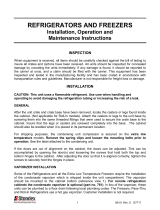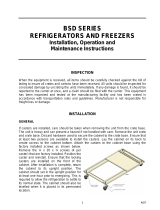Page is loading ...

MILK COOLER STORAGE
Installation, Operation, and
Maintenance Instructions
Model Number: GR422
Serial Number:
Nor-Lake Parts and Service
1-800-388-5253
Nor-Lake, Incorporated 800-388-5253 Parts/Service
727 Second Street 800-955-5253 Sales
P.O. Box 248 715-386-2323
Hudson, Wisconsin 54016 715-386-6149 FAX
Email: [email protected]
www.norlake.com
For any correspondence pertaining to this product, please contact the Service Department of Nor-
Lake, Incorporated. Be sure to include the product model number and serial number with any
correspondence.
© 2005 Nor-Lake, Inc. 9/05 123948

2
INSPECTION
When the equipment is received, all items should be carefully checked against the bill of lading to
insure all crates and cartons have been received. All units should be inspected for concealed
damage by uncrating the units immediately. If any damage is found, it should be reported to the
carrier at once, and a claim should be filed with the carrier. This equipment has been inspected and
tested and has been crated in accordance with transportation rules and guidelines. Manufacturer is
not responsible for freight loss or damage.
INSTALLATION
GENERAL
After the unit crate and base have been removed, locate the legs or casters found in the interior of
the cabinet, if applicable. Legs or casters are optional for this cabinet. Attach the legs or casters to
the unit base by screwing them into the same threaded fittings that were used to secure the crate
base to the cabinet. Insure that the legs or casters are screwed all the way into the base.
LOCATION
The air cooled refrigeration system located on the top of the cabinet requires free air access for
proper operation. Allow a minimum four inch (10.2cm) clearance between the back of the cabinet
and a wall for condenser discharge.
Proper door gasket seal and door alignment are assured when the cabinet is installed on a firm,
level supporting surface. After the cabinet is placed in its permanent location, a cabinet installed
with legs can be leveled by turning the bottom portion of the adjustable legs. Shim material should
be used to level a cabinet that will sit directly on the floor. If casters or legs are not used, it is
required by NSF to seal the cabinet to the floor with an approved sealant such as Dow Corning
#732 silicone.
Examine the door gasket seal by closing the door(s) on a piece of light paper at intervals of
approximately six inches (15.2cm) around the perimeter of each door. When the seal is correct, a
substantial drag should be felt when attempting to remove the paper with the door completely
closed. Each hinge is provided with slotted mounting holes in the wing that is secured to the door.
This feature applies or removes gasket pressure on the hinge side of the door.
If the doors are out of alignment on the cabinet, the doors can be adjusted. This can be
accomplished by opening the door and loosening the screws that hold both the top and bottom
hinges to the cabinet. After adjusting the door so that it is aligned correctly, tighten the screws to
securely hold the hinges in place.
Physical Specifications
Exterior Dimensions Refrigerant
Width x Depth x Height* Type/Amount
63-3/8" x 35-1/2" x 64-7/8" See Serial Tag
(161cm x 90.2cm x 164.8cm)
* Note: Height dimension is without optional legs or casters.

3
ELECTRICAL
Check the proposed outlet to be used to insure that the voltage, phase, and current carrying
capacity of the circuit from the electrical panel correspond to the requirements of the cabinet.
NEVER use an extension cord to power this unit. All inter wiring between the electrical panel and
the unit must be done in accordance with the National Electric Code and all state and local codes.
Refer to Electrical Data below and the Serial Tag for all pertinent electrical information.
Observe all Warning Labels. Disconnect power supply to eliminate injury from electrical
shock or moving parts when servicing equipment.
Electrical Data
Type of
Connection Volt/Hz/Ph
Cord 115/60/1
GENERAL OPERATION
The Milk Storage unit employs a unit cooler evaporator located inside the cabinet as the heat
removing source. Through the refrigeration process, heat is captured in the evaporator, transferred
to the condensing unit on top of the cabinet, and expelled to the surrounding outside air. It is
extremely important to allow a four inch clearance between the back of the unit and a wall for the
refrigeration process to function properly.
During the operation of this cabinet, frost will periodically form on the coil surface. Each time the
compressor cycles "off", the evaporator fans will continue to run, which will keep the internal
temperature uniform and at the same time remove any frost build up on the coil. The water
produced will collect in the unit cooler drain pan and travel down the drain tube to a floor drain or
the optional condensate vaporizer.
GENERAL MAINTENANCE
PERIODIC CLEANING
Beginning with the initial installation, the interior surfaces of the cabinet should be periodically wiped
down with a solution of warm water and baking soda. This solution will remove any odors from
spillage that has occurred. The exterior of the cabinet should also be cleaned frequently with a
commercial grade glass cleaner or with mild soap and water. Never, under any circumstances, use
an abrasive cleaner or alkaline solution.
Monthly cleaning of the condenser will aid the heat transfer characteristics of the refrigeration
system and increase its efficiency. Dust, dirt, and lint will tend to accumulate on the fins of the
condensing unit. This obstruction will affect the flow of air through the condenser, thereby lowering
the efficiency of the system. A wire brush or a brush with stiff bristles can be used to loosen these
particles that are attached to the fins so that they may be removed with a vacuum cleaner. Failure
to keep the condenser coil clean and clear of obstructions could result in temperature loss
and damage to the compressor.
All moving parts have been permanently lubricated and will generally require no maintenance.

4
MAINTENANCE SERVICE AND ANALYSIS GUIDE
REFRIGERATION SYSTEMS - ALL MODELS
MALFUNCTION POSSIBLE CAUSE SOLUTION
Compressor will not start - 1. Service cord unplugged 1. Plug in service cord
no hum 2. Fuse blown or removed 2. Replace fuse
3. Overload tripped 3. Determine reasons and correct
4. Control stuck open 4. Repair or replace
5. Wiring incorrect 5. Check wiring against the diagram
Compressor will not start - 1. Improperly wired 1. Check wiring against the diagram
hums but trips on overload 2. Low voltage to unit 2. Determine reason and correct
protector 3. Starting capacitor defective 3. Determine reason and replace
4. Relay failing to close 4. Determine reason, correct or replace
Compressor starts and runs, 1. Low voltage to unit 1. Determine reason and correct
but short cycles on overload 2. Overload defective 2. Check current, replace overload protector
protector 3. Excessive head pressure 3. Check ventilation or restriction in
refrigeration system
4. Compressor hot-return gas hot 4. Check refrigerant charge, fix leak if necessary
Compressor operates long 1. Short of refrigerant 1. Fix leak, add charge
or continuously 2. Control contact stuck 2. Repair or replace
3. Evaporator coil iced 3. Determine cause, defrost manually
4. Restriction in refrigeration system 4. Determine location and remove restriction
5. Dirty condenser 5. Clean condenser
Compressor runs fine, but 1. Overload protector 1. Check wiring diagram
short cycles 2. Cold control 2. Differential too close - widen
3. Overcharge 3. Reduce charge
4. Air in system 4. Purge and recharge
5. Undercharge 5. Fix leak, add refrigerant
Starting capacitor open, 1. Relay contacts stuck 1. Clean contacts or replace relay
shorted or blown 2. Low voltage to unit 2. Determine reason and correct
3. Improper relay 3. Replace
Relay defective or burned out 1. Incorrect relay 1. Check and replace
2. Voltage too high or too low 2. Determine reason and correct
Refrigerated space too warm 1. Control setting too high 1. Reset control
2. Refrigerant overcharge 2. Purge refrigerant
3. Dirty condenser 3. Clean condenser
4. Evaporator coil iced 4. Determine reason and defrost
5. Not operating 5. Determine reason, replace if necessary
Standard temperature system 1. Control setting is too low 1. Reset the control
freezes the product 2. Control points stuck 2. Replace the control
Objectionable noise 1. Fan blade hitting fan shroud 1. Reform or cut away small section of shroud
2. Tubing rattle 2. Locate and reform
3. Vibrating fan blade 3. Replace fan blade
4. Condenser fan motor rattles 4. Check motor bracket mounting, tighten
5. General vibration 5. Compressor suspension bolts not loosened
on applicable models - loosen them
6. Worn fan motor bearings 6. Replace fan motor
Pan Area 1. No cooling 1. Make sure switch is in the "on" position
2. Too cold 2. Adjust temperature control - see instructions
under pan area
3. Too warm 3. Adjust temperature control - see instructions
under pan area
Nor-Lake, Inc. • P.O. Box 248 • Hudson, WI 54016 • 800-388-5253 Service • [email protected] •
715-386-2323 Sales • 715-386-6149 FAX
/




